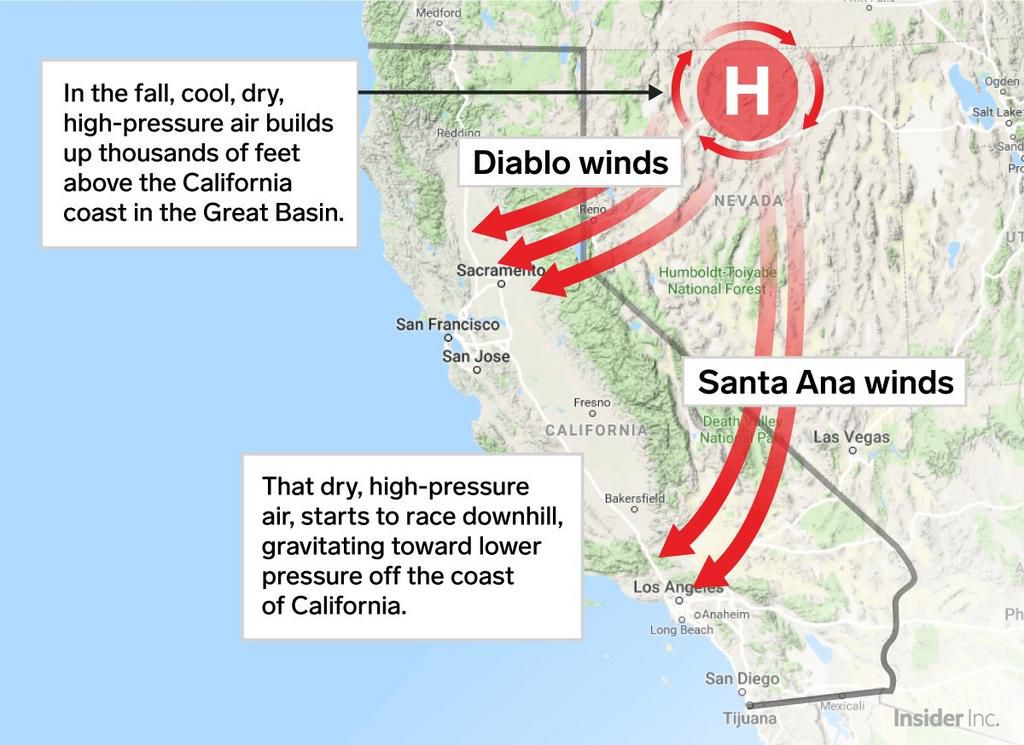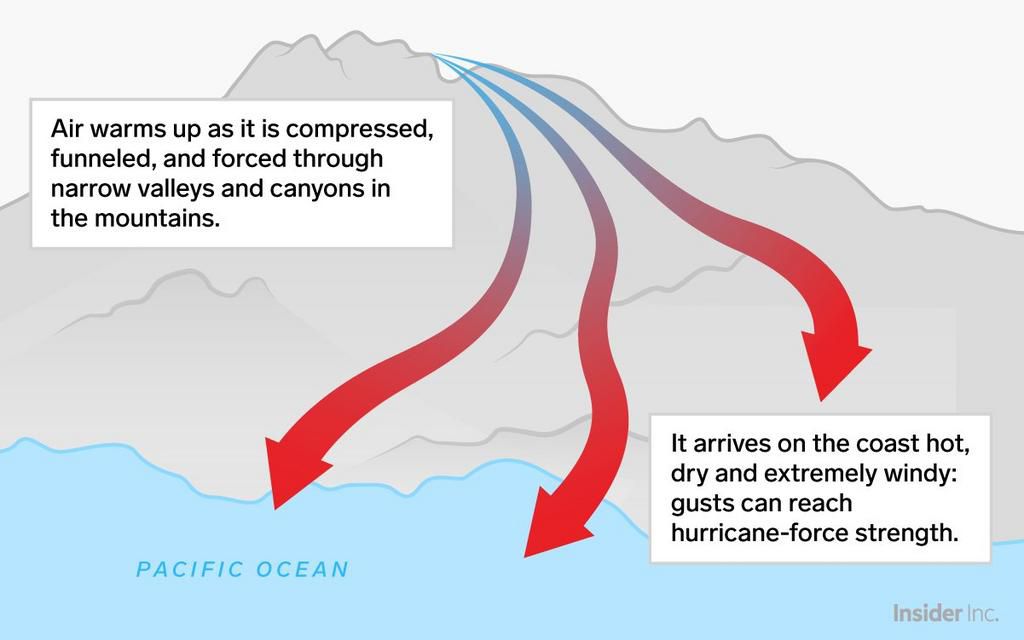The record-breaking year of deadly fires in California was stoked by distinctly devilish winds — here's how they work
)
California endured another record-breaking fire season this year. Dry, hot winds stoked deadly flames that have killed more than 85 people to date.
The Santa Ana winds, which blow into Southern California during the fall and winter months, proved especially brutal this year. They brushed the Woolsey Fire across nearly 100,000 acres of Los Angeles and Ventura counties; those flames killed two motorists who were stranded in a car and another person whose remains were found in a burned home.
The Woolsey Fire and the devastating Camp Fire in Northern California have both been extinguished, and all affected residents are now allowed to return home (though for many there's little left).
Part of the reason the flames spread so quickly and were so hard to contain this year has to do with the winds that fueled them. In the north, they're called Diablo winds, while in the south they are referred to as the Santa Anas.
Angelinos sometimes like to wax poetic about how the dusty, hot winds can change people. Legend has it the warm gusts make people moody, violent, and prone to migraines, fights, or even suicides.
"I have neither heard nor read that a Santa Ana is due, but I know it, and almost everyone I have seen today knows it too," Joan Didion wrote in her Los Angeles Notebook . "We know it because we feel it. The baby frets. The maid sulks. I rekindle a waning argument with the telephone company, then cut my losses and lie down, given over to whatever it is in the air. To live with the Santa Ana is to accept, consciously or unconsciously, a deeply mechanistic view of human behavior."
Scientists who have studied these winds have determined that there's probably no special relationship between positive ions born from hot winds and our mood (though some limited data from Spain suggests that hot, windy days may spark more panic attacks than others.)
But here's what we know for sure.
Where the strong winds come from
High above the California coast in the Great Basin that extends across Nevada, Utah, and other Rocky Mountain states, the winds that will eventually become Santa Anas and Diablos start out as colder breezes.
In the fall, as the desert lands cool down, the high-altitude basin develops chilly, high-pressure winds. All that airin the basin looks for a breezy, convenient escape route.

Santa Anas then heat up on their way downhill. It's a similar process to the Fohen winds of the Alps , the Chinook of the Pacific Northwest, and the Zonda winds in Argentina. These are all called katabatic winds because they move high-density air downslope.
As the winds funnel through narrow mountain passes, they gather speed and heat, becoming stronger and warmer as they descend towards the coast. The phenomenon is similar to what happens when air is compressed inside a bike tire: it quickly heats up.
UCLA meteorology professor Robert Fovell wrote in an online FAQ about the Santa Anas that winds warm at rate of near 30 degrees Fahrenheit per mile.

Rain and the Santa Ana winds
The Santa Ana winds are most strong and able to stoke wildfires in the fall. California has distinct wet and dry seasons, so if the winds arrive before the first rain, that can lead to a high risk of fire.
California's dry periods have been getting longer and more severe in recent years, Federal Meteorologist Tom Di Liberto pointed outin a blog posted on the Climate.gov website . That makes the Santa Anas even more dangerous than usual.
"A dry start to the current water year in October came on the heels of an even drier-than-average summer," Di Liberto wrote. "The resulting dried grasses and vegetation provided plenty of fuel for wildfires to grow exponentially should a fire be lit. And in November 2018, those wildfire powder kegs exploded in both northern and southern California."
Atmospheric scientist John Abatzoglou told Business Insider that he agreed with that assessment.
"Realistically, a lot of the large Santa Ana fire years on record end up being years where we have a delay in the onset of fall rain," he said.
Though less scientific, perhaps the most memorable definition of a Santa Ana wind is the one that's personified in the television show Crazy Ex-Girlfriend.
"I'm ahot, hot breeze that originates from high-pressure air masses" the male chorus version of Santa Ana wind sang in an episode in the show's second season. "Technically, I'm known as a katabatic wind, that's science for: a pain in your asses."
NOW WATCH: Watch a US Navy helicopter squadron fight the California wildfires by dropping huge barrels of water
See Also:
- California's Camp Fire killed 85 people, but the death toll is still changing as DNA from remains gets identified
- For some animals, there are more benefits after a wildfire than you may expect
- Wildfire evacuees are returning to the destroyed California town that's ‘like moving back into a funeral home.’ See the wreckage in a 360-degree video.
SEE ALSO: Wildfire evacuees are returning to the destroyed California town that's ‘like moving back into a funeral home.’ See the wreckage in a 360-degree video.

)
)
)
)
)
)